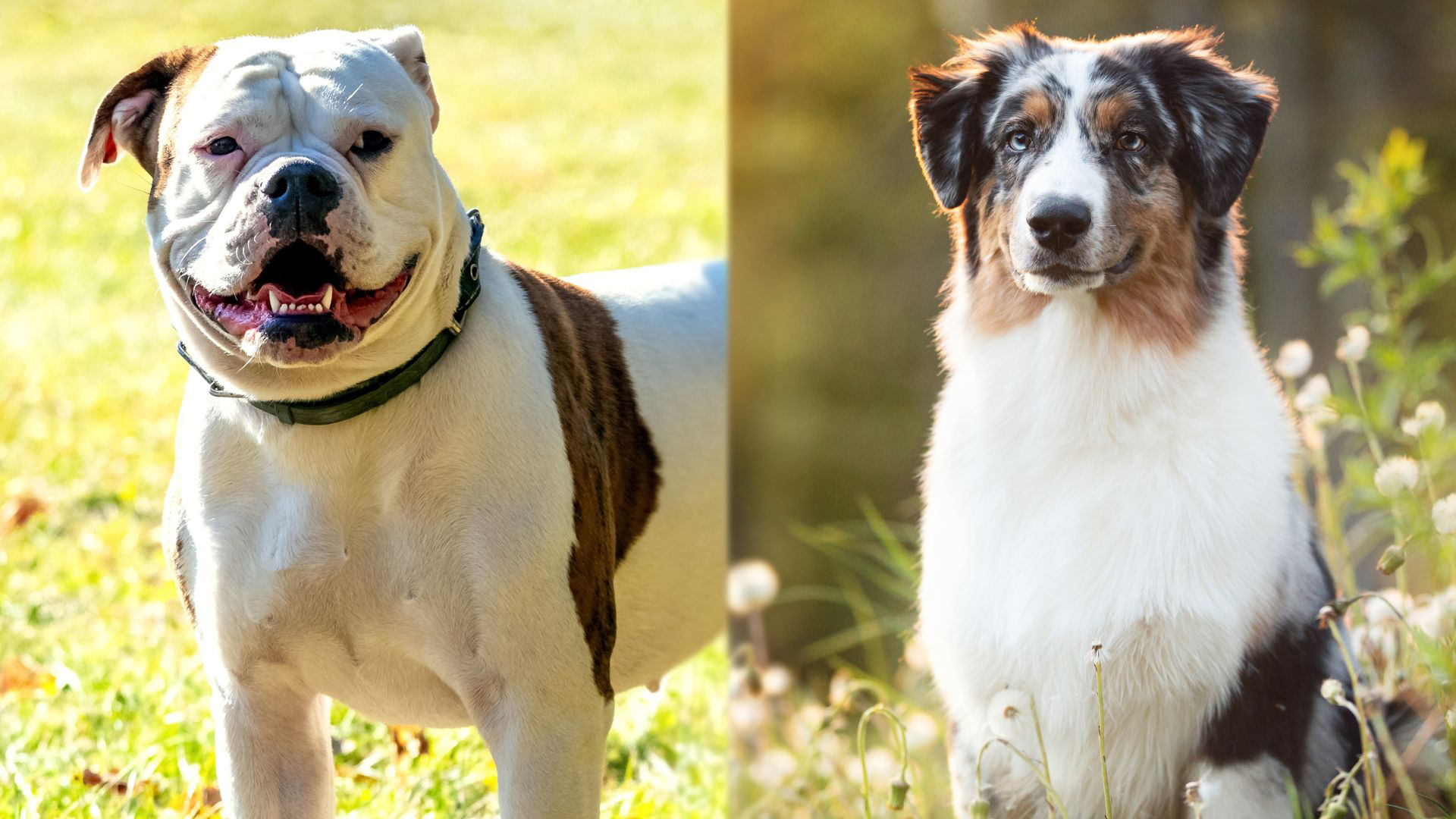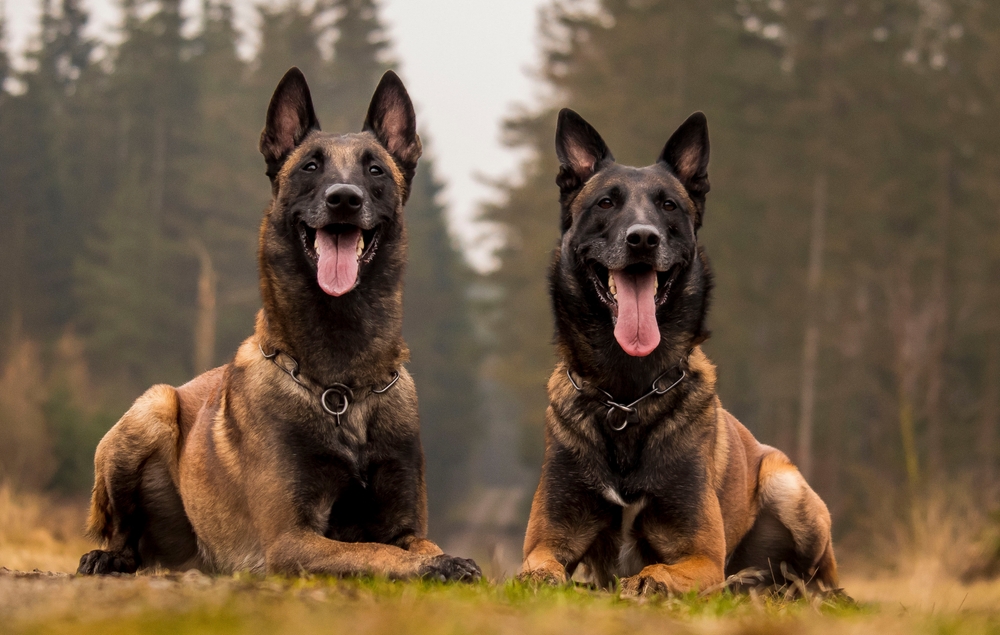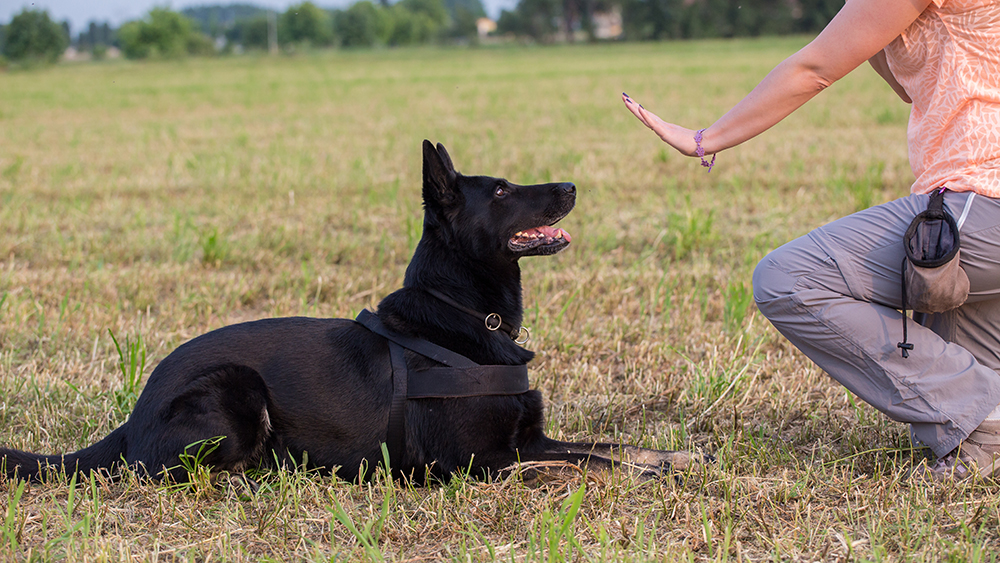Click Below to Skip Ahead
New dog breed mixes are being created all the time, and one of the newer ones around is the American Bull-Aussie. These delightful pups come in a wide variety of colors and are on the larger side; despite their size, they’re quite gentle, playful, and fun. However, there isn’t much known about them yet, so if you’re unfamiliar with the breed, you likely have questions.
Here’s a closer look at everything that is known so far about the American Bull-Aussie. Though there’s still plenty to learn about these canines, what is known so far is that these pups are adorable and lovable. Check out more about the American Bull-Aussie below!
Breed Overview
Height:
16–26 inches
Weight:
50–120 pounds
Lifespan:
12–15 years
Colors:
Wide variety, including red merle, red, blue merle, black, or combinations of these colors; typically have tan or white markings
Suitable for:
Active families, families with older children, active singles, experienced dog owners
Temperament:
Loyal, good-natured, playful, intelligent
The American Bull-Aussie is a mixed breed created from the American Bulldog and Australian Shepherd. The result of this mix has created an adorable pup that often has a coat closer to the American Bulldog who loves spending time with their people and enjoys being active and having work to do. This breed can be a touch stubborn, though, so be prepared for that!
American Bull-Aussie Characteristics
American Bull-Aussie Puppies
Because the American Bull-Aussie is a mixed breed (and a new one), you’ll most likely have to go with a breeder to acquire one of these pups. There may not be a breeder in your area, as there aren’t many breeders of this canine just yet, so be prepared to travel if your heart is set on an American Bull-Aussie. Ensure you choose a reputable breeder by asking questions about your puppy’s lineage and what kind of genetic and health testing has been done.
Regarding personality, this breed will be a delightful mix of the American Bulldog and Australian Shepherd, but how they act as a puppy will depend on which parent breed’s genes are more dominant. However, you’ll no doubt have a lively, silly pup on your hands, no matter which parent they resemble more.
American Bull-Aussie Origin & History
This mixed breed is new enough that there isn’t much documentation on it. As such, the origin of the dog is unknown. We do know about the parent breeds’ origins and history, though!
The American Bulldog likely appeared in the United States in the 1800s and is a descendant of the English Bulldog. Before becoming known as the American Bulldog, the breed had several other names, like the White English Southern Bulldog (a name specific to the American South). These pups worked on farms and ranches and owe much of their continued survival to their ability to take down feral pigs.
Although their name implies otherwise, the Australian Shepherd isn’t from Australia. Nope, these herding dogs are American, through and through! Some of the Australian Shepherd’s ancestors likely came from Europe, though, particularly Spain. This breed is a conglomeration of many sheepdog breeds (not all the breeds involved in the creation of the Australian Shepherd are known, though). It’s likely that this breed’s ancestors include the wolf-like canines that accompanied the Spanish to the U.S. back in the 1500s and possibly the Carea Leonés breed, which hails from Spain. There may also be British-derived sheepdogs in the Australian Shepherd’s bloodline. So, these pups have a rather complicated background!

Temperament & Intelligence of the American Bull-Aussie
This mixed breed pup is intelligent, loyal, playful, and protective of their families. They form strong bonds with the humans around them; between that and the protective instincts the breed inherits from the American Bulldog, this is one pup who will have your back! You will have to engage in plenty of early socialization to ensure that protectiveness doesn’t result in wariness with strangers or aggression with strange dogs, though. Despite their protectiveness, the breed doesn’t necessarily make a wonderful watchdog, as they aren’t very big on barking, so if a watchdog is what you’re seeking, you’ll have to look elsewhere.
The American Bull-Aussie will be quite fond of playing, but as working dogs, they’ll also want a job to do. Without one, they’re likely to become bored, which could cause issues in the home. As playmates, these dogs will be silly, lovable, and super friendly! This breed is also fairly laid-back and calm, so they should be pretty easygoing.
Of course, the breed’s personality can vary somewhat, depending on which parent breed they more closely resemble. So, you may end up with a more protective pup or one who is less protective and instead simply devoted and dedicated to their family.
Are These Dogs Good for Families? 👪
The American Bull-Aussie gets along exceptionally well with children, so they make fantastic companions for families. However, because they’re a larger breed, having them around small children may not be ideal; while these pups are calm and non-aggressive, they could still knock a tiny human over if playtime gets a bit wild. So, families with young children may want to consider a smaller breed.
Does This Breed Get Along With Other Pets? 🐶 😽
This mixed breed should get along well with other canines, provided the American Bull-Aussie has undergone extensive early socialization and is carefully introduced to new dogs. However, because this breed’s parents are both working dogs—and herders, at that—smaller animals, such as cats, rodents, or ferrets, may not be ideal to have in the home at the same time. The American Bull-Aussie could decide smaller animals need to be herded, which could result in issues.
Things to Know When Owning an American Bull-Aussie
There’s much more to know about properly caring for one of these canines. You need to know the sort of health conditions they’re prone to developing and how difficult or easy training one of these dogs is, among other things. Here’s a closer look at everything you should know before adopting an American Bull-Aussie.
Food & Diet Requirements 🦴
All canines require a diet of high-quality dog food rich in protein. The American Bull-Aussie would likely do best on food designed explicitly for dogs of their size, too. When it comes to how much to feed your American Bull-Aussie, speak with your vet. How much food a dog requires depends on various factors, like their age, activity level, size, and more. Your vet will best be able to tell you how much food is suitable for your pup.
Exercise 🐕
This breed is relatively active (though they aren’t the most active canine breed around), so you should expect to engage your American Bull-Aussie at least 45 minutes a day with exercise and playtime. Exercise can be broken into a couple of sessions involving walks, jogs, or even a game of tag in the backyard.
Playtime is vital to keep your canine companion physically and mentally stimulated. Because this breed is derived from two working dog breeds, they will enjoy having jobs to do. If they don’t have a job around the home, they’ll need plenty of mental stimulation to keep them from becoming bored, as boredom can lead to a destructive pup. So, challenge your dog to think on their feet with puzzle games or even agility courses set up in the yard!
Training 🎾
Though the American Bull-Aussie is intelligent and generally enjoys pleasing people, this pup is also on the stubborn side and can be strong-willed. As such, training them can be challenging, which is why these canines aren’t recommended for novice dog owners. However, training (and early socialization) must be a priority with this breed so they can learn to be friendly with people outside their family and other canines.
Training every day with your pup in 5 to 10-minute increments can help keep these canines on track. Remember to use only positive reinforcement during training, as negative reinforcement could hinder training efforts. And don’t be afraid to reach out to a professional if you need help! (In fact, enrolling your pup in a basic obedience class is an excellent idea for this breed, no matter how well training on your own is going.)
Grooming ✂️
This is a breed that is very low maintenance when it comes to grooming. Because the American Bull-Aussie’s coat often resembles the American Bulldog’s coat more than the Australian Shepherd, they only require brushing once a week. Your pup should only be bathed as needed unless they get particularly dirty. Depending on which parent they take after more, the American Bull-Aussie may have a few wrinkles on their face; if so, these should be cleaned regularly with wipes to prevent oil and dirt build-up that could result in infection. Other than that, your pup should have their nails trimmed once or twice a month, their teeth brushed on a regular basis, and their ears cleaned weekly.
Health and Conditions ❤️
Since there isn’t much documentation on this breed yet, it’s difficult to say what health conditions the American Bull-Aussie could be prone to; chances are good, though, that they will be more likely to develop conditions or illnesses that affect their parent breeds. (However, if you’re getting your American Bull-Aussie from a reputable breeder, the pup should be relatively hardy.) Here are some possible conditions this dog could inherit from the parent breeds.
- Cataracts
- Cushing’s Disease
- Bloat
- Elbow Dysplasia
Male vs Female
Other than a possible difference in size (with the male being a bit larger than the female), there shouldn’t be any significant differences between males and females of this breed. This breed’s personality depends on which parent they resemble more and not their sex.
3 Little-Known Facts About the American Bull-Aussie
Here are a few more things to know about the American Bull-Aussie.
1. This breed can be prone to separation anxiety.
These canines want to be with their people all the time, and if they aren’t, they could develop separation anxiety, which could lead to unwanted behaviors. So, if your family doesn’t have someone home during the day, this may not be the best breed for you.
2. The American Bull-Aussie may get winded quickly.
Though this breed is quite active, they can get rather winded quickly, so taking them on super long walks or a day-long hike probably isn’t ideal. Short play sessions, walks, or jogs are more than appealing to these pups, though!
3. Australian Shepherds can be heterochromatic.
Heterochromatic means the eyes are a different color; one is usually blue and the other brown. However, whether this trait passes to the American Bull-Aussie remains to be seen.
Final Thoughts
While we don’t know much about the American Bull-Aussie just yet due to the newness of this mixed breed, we do know these pups are affectionate, playful, silly, and protective. If you’re lucky enough to find and adopt one, you’ll have an energetic best friend who wants to be constantly by your side. Just be prepared for some travel if you’re determined to hunt one of these canines down!
Featured Image Credit: (L) MVolodymyr, Shutterstock | (R) Anastasiia Cherniavskaia, Shutterstock












